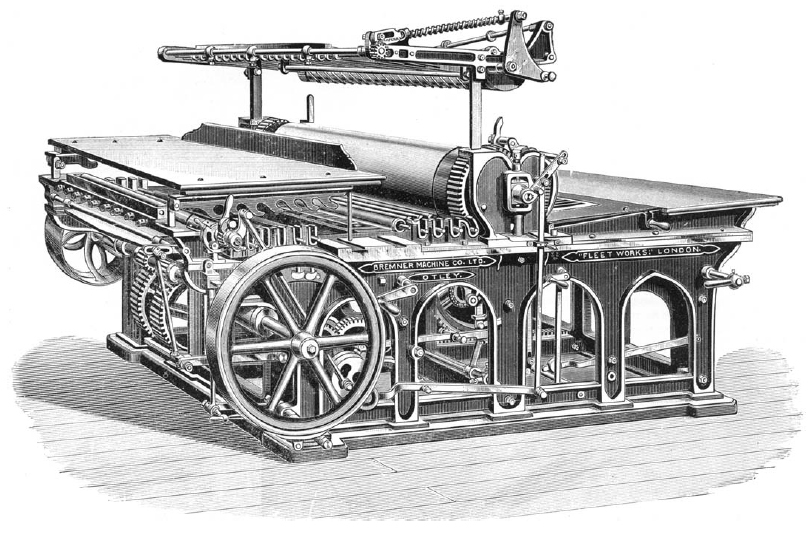
History
From Humble Beginnings..
We’re going to take you on a special journey from humble beginnings up to the present day…
Our story is one of overcoming challenges and adversity set against a backdrop of some turbulent periods in our nation’s history, our mission throughout our journey has always been the same, that is to bring you, our readers, the news and a diverse range of articles for your interest and pleasure. The Journal is published by Coates & Parker and the publisher’s foundation more than two hundred years ago was the result of dramatic incidents set against the colourful backdrop of the Napoleonic Wars, when travel across the seas and oceans took place in wooden sailing ships and journey times were at the mercy of the prevailing winds. However, it surely was a dramatic way to travel, imagine if you will, looking up from the deck to see huge sails full of wind and listening to the sound of billowing canvas and the unmistakable smell of the salt spray as an isolated community of sea farers plies its way to some distant shore.
The Beginning
Our story begins in 1796 when Miss Vardy of Bury St. Edmunds, Suffolk, married John Buckler and they moved to settle in Warminster. Her brother, Joshua Lambert Vardy, had trained as an independent church missionary and he set sail in December 1798 with his wife and others aboard ‘The Duff’ bound for Tahiti, about midway between Australia and South America in the Pacific Ocean with the aim of spreading the word of the Christian faith.
A French privateer – Le Grande Buenaparte, captured The Duff as the ship was heading south; as she was unarmed her captain had no choice but to heave-to and be boarded. Joshua Vardy and others were taken to the Montevideo area of south Uruguay. They then managed to board another ship in May 1799 bound for Rio de Janeiro in Brazil. Unfortunately they were captured again, this time by a Portuguese ship heading for Lisbon. The missionaries felt that their mission was not to be and decided to return home. At Lisbon they boarded The Prince of Wales and others gained passage on Fortitude and they set off back to Britain, arriving on 13th October 1799.
.
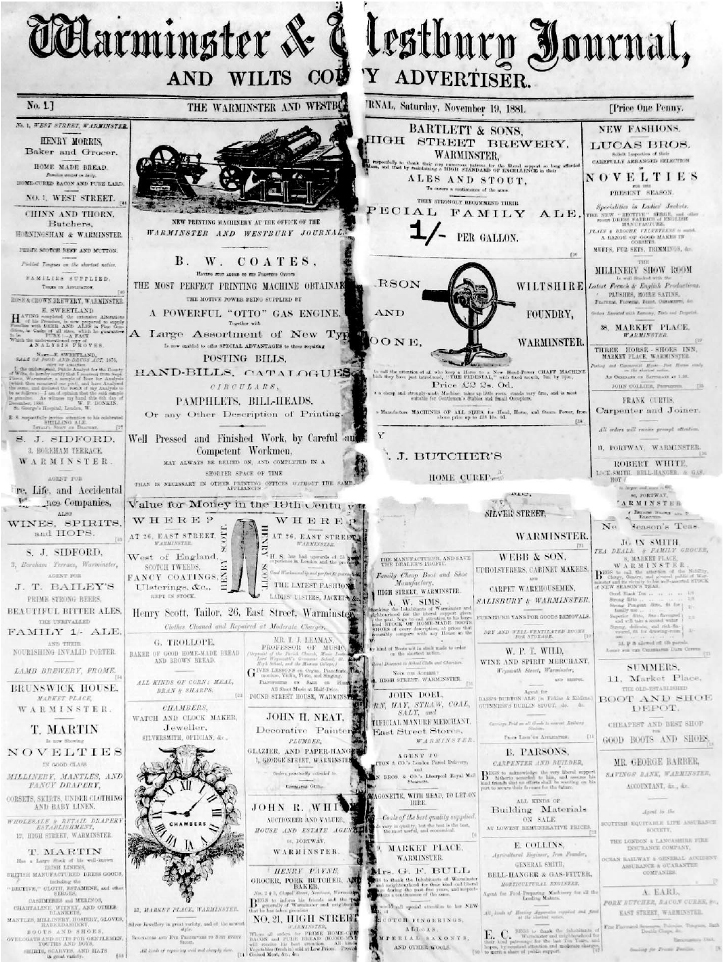
The front page of the first issue of The Warminster and Westbury Journal and Wilts County Advertiser
The Warminster Connection and Printing
Joshua Vardy then came to Warminster, whether it was because he had family members here or Independent Church Colleagues is not known. It is believed he was trained in the craft of printing at missionary college – we know that the Warminster Missionary College included printing lessons in its curriculum around 100 years later. He started a printing business in 1799 or 1800 and the foundations for Coates & Parker were laid. The earliest surviving example of his work was a brochure for an auction of land that was held in the Weymouth Arms in July 1810.
The imprint on the document reads: Vardy, Printer, Market Place, Warminster. It is not known if he occupied the current premises at this time. The printing presses of this period were made of wood and quite cumbersome to operate so he made the decision to invest inthe latest technology of the time and purchased a cast iron Columbian printing press in 1815, one of the first of its kind to improve production speed and quality. This press is still in working order in the current premises. In 1823 we know that Joshua Vardy was in Coates & Parker’s current premises at 36 Market Place as a lease was granted to him for a stable and yard – this being the composing rooms used up until the late 1980s – for the sum of £13, paid to William Baily and Stephen Hunt, the landlords of the Red Lion public house. By this time he had built up a successful and thriving business and in 1831 he printed a ‘Catalogue of Organic Remains of the County of Wilts’ by Etheldred Benett an outstanding geologist of her time living in Norton Bavant.
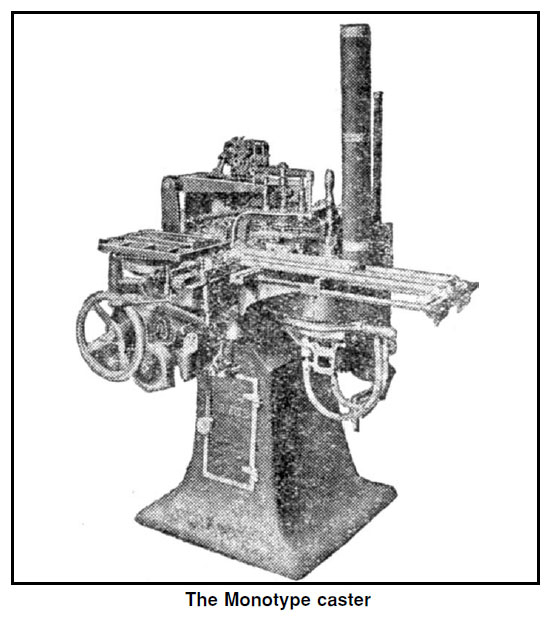
Joshua Vardy passed away in 1834 and the business was passed down to his son Richard Elliot Vardy who had been working with his father for some time and who continued the craft and ventured into the newspaper business, publishing The Warminster Miscellany. This was a monthly digest of news that ran from January 1854 until December 1863. After this time he promoted the Warminster Parish Magazine and Church, which we believe, he printed.
The Warminster Journal is founded – the Coates connection

An early press used for printing the Warminster Journal
Benjamin Walter Coates moved to Warminster in the 1860s during a time of dramatic change. The coming of the railway had a profound effect on the town and the way agricultural business in the area was conducted. He was the son of the Rev. John Coates, headmaster of King James’s School, Almondsbury, and vicar of Longwood, and grandson of the vicar of Huddersfield. Benjamin Coates bought the business in 1876, continuing in a similar way to Richard Vardy. However his mind was on newspaper publishing and it could well have been his political leanings that moved him in this direction. Over a 19-year period he gained a reputation as a loyal churchman and Conservative. He founded the Warminster and Westbury Journal and Wilts County Advertiser as a weekly broadsheet newspaper (about twice the page area of today’s tabloid edition) and the first edition was published on Saturday 19th November 1881.
The paper was the result of meticulous planning and some considerable investment in staff and machinery. An extension to the premises had been built for the machine room the previous year and occupied half the garden, using the wall to support the roof – planning regulations were no doubt a little less prescriptive in those days.
Every letter in the paper was set by hand and photographic illustrations had not been invented; pictures were printed from hand-cut wooden blocks, like the picture of the printing press shown in this supplement. A day’s work for a compositor was a column and a half of solid text – the columns were wider than they are today being two and a half inches (63.5 mm) as opposed to the current 44 mm. They were also a lot longer.
A new state of the art gas powered printing press was installed and the building was gas lit. The Columbian press was retained as the business still carried out a variety of jobbing work including posters, letterheads, booklets and a great variety of other printed items for a considerable number of customers. As more powered printing presses were introduced the Columbian press became less used, however it was still retained and used to produce proofs and it was still being used for this purpose during the latter part of the twentieth century.
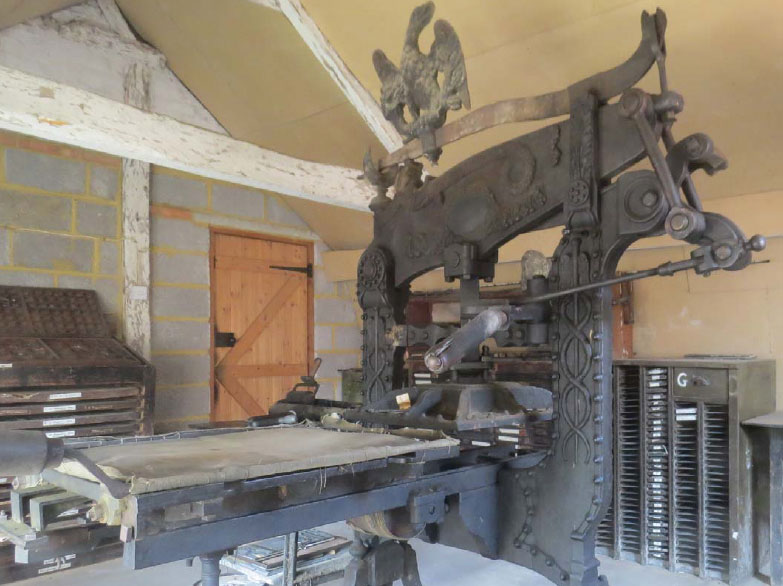
The Columbian Press
Every week the paper was filled with local and national news and a large number of adverts to keep it interesting and commercially viable. In 1885 and again in 1886 it was published daily, however, the extra editions were only slips of paper giving the general election results for the House of Commons in London. According to the slip Benjamin Coates had received them by telegraph. The direct competitor to the Warminster Journal was the Warminster Herald that commenced publication in 1857. This ran for 36 years before ceasing publication in 1893.
He had noble ambitions for his new newspaper. In his first editorial he wrote, ‘In the columns of the Journal we shall endeavour to give correct reports of meetings of various bodies on religious, social or political topics, proceedings in the County Court and at Magistrates Sessions. Parliamentary and political intelligence as well as domestic and foreign will be collected from the most reliable sources; and impartial accounts of passing events and occasional articles on the leading and engrossing topics of the day will be given.’
The Journal’s Journey –the early years
It was indeed a time of tumultuous change when the Journal was founded. Warminster was no longer a major agricultural centre, no longer a centre of anything. Around 25 years later
one of the Journal’s own correspondents was to look back over half a century of steady decline and write this elegy to the lost golden age, poignant, nostalgic and indignant.
‘In harking back to the old times some lingering reminiscences may be recalled of quiet Friday evenings wandering on the downs, to which distance of time has lent an additional halo; when, added to the charm of the tinkling sheep bells of the bell wethers at Durtley and Mancombe, came floating on the breeze from far and near the jingle of the merry bells on the horses’ heads, of which the carters and the horses, too, were so proud.
‘The teamsters were bringing their argosies of golden grain to be disposed of in market. Some few old natives enthuse of these memories of campanology. How the Imber teams would be echoed by those approaching from Westbury Road, and both those from the Bath Road, soft and low; then, anon, louder, according to the sough of the wind or the acoustics of the intervening space; dying away, then bursting again on the ear with distinctness.Those evening bells, those evening bells! Verily a merry peal and concord of sweet sounds, indicating approaching wealth to Warminster.
‘The writer was warned against the danger of driving to Warminster on Friday night, from the roads blocked by farmers’ teams, converging on Warminster from six points of a star to its centre, when that star was in such effulgent ascendance.
‘Then a little army of sack carriers used to get a good living, and carters fight for precedence of position in the Market Place.
‘Report used to say the savoury smells exhaled from the cooking joints, and appetising scents from the steaming kitchens could be sniffed from Copheap, and assailed the olfactory nerves of the approaching marketer half a mile away. Now how stands it?
‘Then, 500 wagon loads of corn have been known to come in one day (or rather night, for they were arriving all night long), some from the centre of Dorset. And the wagons, there was no room for them at the inns! They would extend from Hatchet’s Corner down to the White Hart, the whole length of Market Place, High Street and George Street.
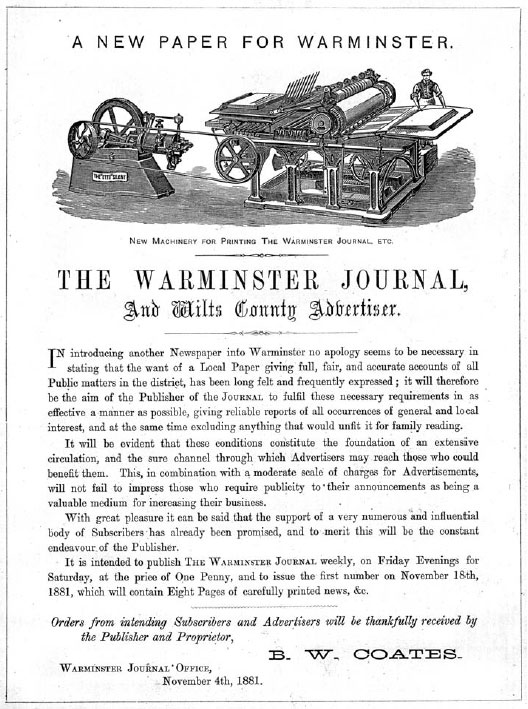
A leaflet promoting the Warminster Journal
‘Now where are they, the wagons and the tons of thousands sacks of corn! Isn’t it pitiful, where once for a city full, now there are none?’ Benjamin Coates retired in 1898 having been father to ten children. The business passed to the youngest of his six sons, Alfred. Benjamin Coates passed away in 1900 having won the esteem of all with whom he was brought into contact.
Warminster Journal – the next generation
Alfred Coates took over as editor in 1898 and remained in this position for around 60 years, a phenomenal feat; he was 28 when he took up his position and 89 when he died. He steered the Journal through two world wars, a depression and six monarchs, seeing the end of horse drawn carriage as a means of mass transport and its replacement by cars, buses and lorries. He also saw in the development of mass passenger air travel, nuclear submarines and the birth of the space age – an incredible number of changes in the world as he knew it the during his tenure as editor of the newspaper.
Under his leadership the paper continued and every week local people eagerly awaited for the Journal to hit the news stands. However the First World War did cause problems. Many of the staff had enlisted into the army and subsequently many more had been called up. To deal with the labour shortage Alfred Coates purchased a Monotype system in November 1916. This facility used two members of staff instead of half a dozen: one typed the text onto a coded paper roll and the other fed the roll through a machine which cast the text directly into columns from molten lead – unfortunately the gas supply was not always sufficient and the machine could not always be used.
The war continued and more staff were enlisted into the armed forces until in the middle of April 1918 it was found to be impossible to create the paper and production was suspended. The next issue, when staff had returned and been released from the armed forces was issue 1,920 dated 15th August 1919.
Publication then continued, issue 1,000 had been in 1900, 2,000 was in 1921. During the mid 1920s electricity was installed in the building and replaced the gas lighting and the gas engines that had driven the printing presses and the Monotype system. Issue 3,000 was published in 1940, 4,000 in 1959, 5,000 in 1978 and 6,000 in 1997.
Until October 1912 the Journal imprint bore one name only – Alfred’s. After this date it has recorded the 23-year partnership with Samuel Hillier Parker, who moved to Warminster from Sunderland in 1900 where he had been working for one of Alfred’s older brothers. Sam served a 12-year assistantship and was then promoted and given a partnership. He stayed with the firm until his health broke down. He passed away in 1935 at the age of 59.
Another Coates & Parker long serving member of staff was Henry Boyce Edwards of North Row, known to all at the Journal as Harry Edwards. He had been at the printing works since before the Journal was born.
Harry worked for the firm for 61 years and at the end he was chief compositor, chief sub editor and head teacher. Able to look back on a long career as an urban councillor – he was chairman in 1918 – he was also father of the local fire brigade. In 1936 when illness began to get the better of him, the Golden Jubilee dinner was postponed because the men refused to celebrate without him, later in that year on the night it eventually went ahead in his absence, it was the night he died.
This was the Harry Edwards who administered justice with a pair of typesetter’s tweezers in his hand. The first working man to become a magistrate on the Warminster bench he took the oath in 1924, having been an ex-officio JP at the end of the Great War when colonial troops were stationed in the neighbourhood and the police court sat daily.
These were not his only claims to parochial fame. Admire the Lake Pleasure Grounds and you admire his foresight, as it was under Harry’s chairmanship that the Parks Committee decided to tackle the local unemployment problem by creating a rare example of enlightened town planning out of a rubbish dump. Bowler hat and black apron Harry Edwards departed this world in his 77th year.
More years passed and now there was a war on. Everything sort of carried on, the Second World War also took employees away, however, some who had fought in the First World War were now too old to enlist in the armed forces. One such man was Charlie Mills – as much as by historical accident as by personal design he became Alfred Coates’s second string. Too old to fight he kept the Journal alive through the war almost single handed, doing everything from reporting what happened in a strangely transformed world to operating the machines he learnt his craft on as an apprentice around 30 years before.
A new owner for the Journal and a new era
The war ended and Alfred Coates’s health began declining and in 1958 he decided he should retire. Various commercial interests offered to buy him out, however, he was still sharp enough and in tune with the changing business environment in publishing to realise that selling to a hard headed outside interest would spell the death knell for his newspaper’s independence. In the end he sold it to Charlie Mills.
When Benjamin Coates founded the Journal the state of the local economy was not favourable to him and when Charlie Mills bought it the post war epidemic of newspaper deaths had already claimed its first victims. There was radio, television and more affordable motorised transport to contend with and reading and writing seemed to be going out of fashion.
In these circumstances what hope was there for a 60-year old man who’d just taken over a local institution that belonged to a different era, its stained timber walls decorated with faded First World War maps and engravings of long dead cricketers, with floors bending under the weight of ancient shadows. Charlie was a remarkable man and under his leadership the Journal survived and reached better weather. Charlie Mills passed away unexpectedly in March 1970, having been a founder member of the town Chamber of Trade, a past president of the Wiltshire Football Association, a qualified football referee, member of Warminster Rotary and a prominent Conservative – as well as a oneman newspaper.
The paper was now run by his widow Elsie and their daughter Gladys.
Over the years the Journal has engaged the services of a number of reporters who developed a style all of their own contributing to the special way the paper has delivered the news and informed its readers down through the years. These included: Cliff Goodman, Arthur Shuttlewood, who almost single handedly elevated Warminster to global attention with the UFO phenomenon during the 1960s award winning journalist Kevin Mount and the inimitable Ray Beatty.
New technology at the Journal
Setting the Journal using the Monotype system continued right up until the early 1980s, then computer technology was introduced. In 1984 a basic APL typesetting system was installed plus a Linoscreen Composer, which enabled the pages to be designed on screen. The Warminster Journal was one of the first papers nationally to go ahead with a system like this as the nationals had an impossible situation with the unions, as many of their staff would have been made redundant. For the Journal, however, several compositors were due to retire and the younger members were keen to keep their hands clean at work!
This system lasted a number of years but ever advancing computer development soon outshone its ability and in 1991 a Macintosh networked computer system was installed at the Journal, as was a typesetting program called Quoin (named after the old compositors’ device for holding together pages in the past). Quoin was a local program having been written in Frome just seven miles away but was chosen for its ability to do the work required at the Journal. Quoin is still used along with programs like Photoshop and Acrobat.
After the paper had gone over to computerised setting other things also affected production – the number of pages increased to 24 most weeks and occasionally 28. Sales increased reaching a print run of 6,000 one week. In order to be able to continue under these circumstances it was realised that the press would need to be enlarged and updated, but this would have meant clearing the machine room of other presses used for jobbing work to make room for it. Therefore the decision was made that the Journal print run would be outsourced.
Recent years and looking to the future
Initially it went to Marcher Web in Dilton Marsh – they relocated to Frome but soon went out of business. The print run was then moved on to Wiltshires who were in Bristol but their reorganisation made it unwanted and it was moved to Staverton Press in Gloucestershire. In time it was moved again, this time it went to Newbury News who to our delight had a press that printed full colour for very little extra cost. However they closed their press room at the end of 2017 and the the Journal is now printed in Weymouth.
Throughout its long history the Warminster Journal has invested in new technology where it has been shown to benefit the production of the newspaper. As we move forward into the future with more publications going to a digital platform the Journal will remain as a paper medium for some time to come. It is believed that this best suits the paper’s style and current readership.
Charlie’s grandchildren, Ray Shorto and Diana Watkins (née Shorto) are now joint editors of the Journal, both having worked in the business for many, many, years. Ray studied printing at Radstock College and then attended the London College of Printing. Ray graduated from the Open University with an honours degree in science. After all these years Ray still regularly practices his craft and can often be found operating the printing presses he had grown up with.
The faith of the founder is something that has continued down through the years – Alfred Coates was believed to have been involved with Christ Church and was a feoffee of the Chapel of St. Lawrence from 1916 until his death; Charlie Mills was involved with the Minster Church as churchwarden; and Ray Shorto was involved with Christ Church and now the Minster, he has also been afeoffee of the Chapel of St. Lawrence since 1999.
On its journey from its beginnings in the Victorian era to the current time the paper has steadily evolved to meet the needs of its readership and it will continue to do so.
All of us at the Journal are looking forward to a positive future where the paper will continue to deliver interesting news and engage with its readership, we invite you to continue the journey with us.
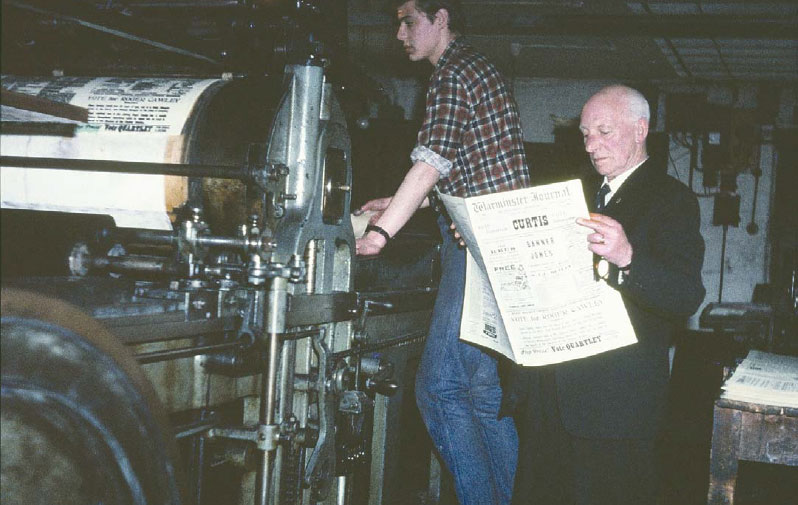
A leaflet promoting the Warminster Journal
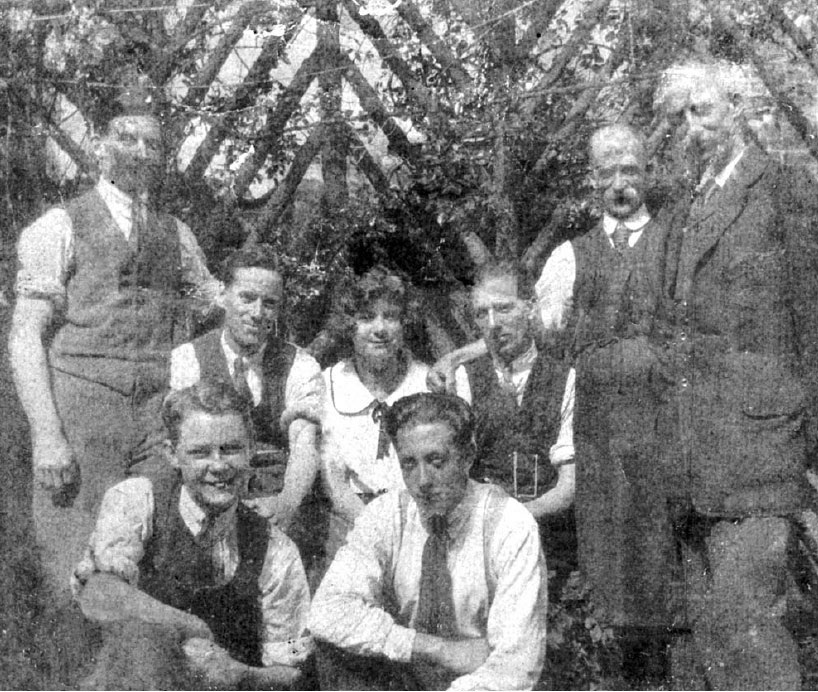
A photograph of Coates and Parker staff taken after the Great War

